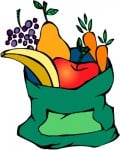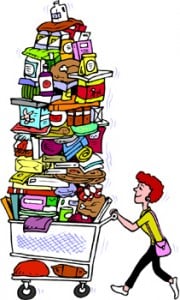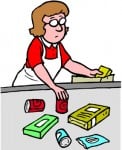Grocery Shopping in English
Posted by: Tara BenwellPodcast: Play in new window | Download (0.0KB)
Subscribe: Apple Podcasts | Google Podcasts | RSS | More
A grocery store is also called a supermarket or a greengrocer. Chain grocery stores are referred to by name. Learn the names of these stores before you travel to a new country. Superstores or department stores often have full grocery sections inside.
Shop Smart
Grocery stores are set up for you to buy more than you need. Fresh foods and staples are usually placed in the outside aisles or at the far end of a grocery store.
At the front you will find convenience foods and sale items. At the checkout you will find things you probably don’t need, such as chocolate bars and magazines. The store is counting on you to throw a few of these items into your cart or basket. This is called impulse shopping. Can you resist the temptation?
Gathering and packing
Most grocery stores offer a variety of options for gathering and packing items. Don’t be surprised if you have to buy your bags.
- shopping cart: pushcart on wheels (you may have to put a coin deposit in the slot)
- basket: plastic container with handles; useful for quick grocery trips when you only need a few items
- box: sometimes available for free at the checkout
- plastic or paper bags: you may have to pay for these
- reusable bags: bring your own (or buy and reuse)
Main Aisles and Sections
Here are the main aisles (or sections) in a grocery store as well as some example items you will find in them.
produce: fresh fruit and vegetables
frozen food: juice, pizzas, fruit and vegetables
bulk food: peanuts, candy, flour, snacks (You bag yourself. You choose the amount.)
baking: pre-packaged goods such as flour, sugar, salt, and chocolate chips.
breads: packaged breads, bagels, hamburger and hot dog buns
meat and seafood: packaged beef, chicken, fish
deli: freshly sliced meats and cheeses (You tell the butcher how much you want.)
bakery: fresh breads, muffins, cakes to order
dairy: milk, eggs, dairy, yogurt
pasta and rice: spaghetti, penne, wild rice, whole wheat pasta
ethnic foods: foods from countries in other parts of the world
canned foods: beans, pasta sauce, canned fruit and vegetables
condiments: ketchup, BBQ sauce, salad dressings, oil
snacks: chips, packaged candy, cookies, crackers
cereal: boxed breakfast cereals and bars, oats, granola.
beverages: juice, pop, coffee, tea,
household items: toilet paper, tissue paper, garbage bags, detergent, diapers
health and beauty and or pharmacy: make up, deodorant, feminine products, medicine
Checkout
Read the signs above you before you get into a line.
- express checkout: For people buying a few items. The sign will show how many items you are allowed to have (1-12).
- automatic checkout: You swipe and bag your own groceries and pay with a credit or debit card.
- closed: Many stores use a lighting system to show which line ups are open for service. If the light is on the aisle is likely open.
Questions to ask in a Grocery Store
You don’t always need to ask someone who works in the store. The shopper next to you may be able to tell you where to find the sugar.
- Can you tell me where the produce section is?
- Can you do a price check for me?
- Do you have prepackaged candy?
- Do you have more flour in the back? (if a shelf is empty)
- Is this on sale?
- Do you sell stamps, lottery tickets, alcohol? (grocery stores in some countries are not licensed to sell alcohol)
Discounts
Do you have a discount card? Many clerks will ask this. Membership cards at grocery stores are usually free. They provide you with a discount on many items. Are you going to use this store a few times? Fill out a form and get a card! It will be worth your time. If you don’t have a card, don’t be fooled by the prices on food. Many foods are advertised at membership prices. Without a card you’ll pay a higher price. Brand-name items are typically more expensive than no-name or store-named items.
Common Courtesy
If the person behind you only has one or two items, you can invite the shopper to go in front of you. Say, “You can go ahead of me. You’re just buying a few things.” If there is a divider (small stick) on the conveyor belt at the checkout, place it after your items. This will allow the person behind you to start placing his or her groceries down too.
Grocery Shopping Tips
Did you write out a list? Creating an English grocery list is a fun and simple way to practise English. You can even create a master list using the sections above. Add subcategories for all the foods you normally buy. Leave extra spaces for special items that you need once in a while. If you’re shopping with children, bring a snack or toy!
Related
How to Shop
Weights and Measures
English for Cashiers
Food Idioms
Tara Benwell is a Canadian freelance writer and editor who specializes in materials and articles for the ELT industry.
© EnglishClub.com
18 comments
-
Nick says:
A very helpful website with a lot of useful information!
-
Sofiya says:
Hi I am interested in eating healthy because I want to keep my body healthy and clean and so and I can reduce the germs in my body
. -
Charu mathi says:
Useful for me and Thank you
-
Milon says:
Your blog is nice
-
Atena says:
Hello
When buying food and cosmetics, I pay attention to their production and expiration dates. It is important to me that the food I eat is organic. I like to eat more white meat and fish in my diet because it is better for the body.
-
vali says:
This information is useful and It helps me for shopping smart.
-
Dr kadhar khan says:
Our Lotus Grand Exports offer you all varieties of Indian Food, Spices, and General Provisions, pooja items, utencils, etc., We are specialized in the export of Branded products, products in customer’s own Brand, tailor-made products as per customer requirement. We will arrange various food products in a consolidated container. We also guarantee the best prices and assure on-time supply.
-
Humberto Encinas says:
Good information.
-
Melany Pastrana says:
Thank you for all the tips
-
erika soto says:
good
-
Ziyad says:
Thanks
-
Gerry Espinoza Velarde says:
On my local context , about the question referring to having more flour (typically wheat) in the back? (if a shelf is empty) I practiced before but with oatmeal and all depends at the end of the day on the employee mood or at the hour of the store schedule: if it’s early I may be attended, but if it’s at the evening normally nobody is at the floor. That is why only an early morning lone star cowboy could understand me at my nearest HEB, yes indeed.
-
Elvin leonel rubi cruz says:
Nothing
-
Gonzalez says:
Says that is good for questions to ask in a grocery store
-
Horacio Atehortua Jaramillo says:
It served as a great help to strengthen my skills and concepts on the subject.
Thank you so much. -
Valentina Echeverry says:
good
-
wenyun ren says:
That is good
-
Francis Acosta says:
hi,
i´m interesting for the healthy food because i like be careful when i eat anything.
so i think that we should becareful when we eat meat a lot because it´s not better for our heath.
thanks
 A grocery store is also called a supermarket or a greengrocer. Chain grocery stores are referred to by name. Learn the names of these stores before you travel to a new country. Superstores or department stores often have full grocery sections inside.
A grocery store is also called a supermarket or a greengrocer. Chain grocery stores are referred to by name. Learn the names of these stores before you travel to a new country. Superstores or department stores often have full grocery sections inside.
 Most grocery stores offer a variety of options for gathering and packing items. Don’t be surprised if you have to buy your bags.
Most grocery stores offer a variety of options for gathering and packing items. Don’t be surprised if you have to buy your bags. Read the signs above you before you get into a line.
Read the signs above you before you get into a line.